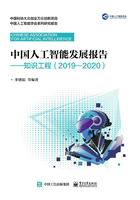
参考资料
[1] Ruqian Lu,Xiaolong Jin,Songmao Zhang,Meikang Qiu,and Xindong Wu. A Study on Big Knowledge and Its Engineering Issues,IEEE Transactions on Knowledge and Data Engineering,2018.
[2] Ruqian Lu,Chaoqun Fei,Chuanqing Wang,Shunfeng Gao,Han Qiu,Songmao Zhang,Cungen Cao. HAPE: A Programmable Big Knowledge Graph Platform,Information Sciences,2020(509)509:87-103.
[3] Ruqian Lu,Chuanqing Wang,Xikun Huang,Songmao Zhang. B-Sparql-A Typed Language for Querying the Big Knowledge,International Conference on Knowledge Graphs,2020.
[4] Big data,bigger opportunities: Investing in information and analytics,https://www.slideshare.net/jmclough/big-data- 2013powerpoint.
[5] X. Jin,B. W. Wah,X. Cheng,and Y. Wang. Significance and challenges of big data research,Big Data Research,2015,2(2): 59-64.
[6] X. Wu,H. Chen,G. Wu,J. Liu,Q. Zheng,X. He,A. Zhou,Z.-Q. Zhao,B. Wei,M. Gao et al. Knowledge engineering with big data,IEEE Intelligent Systems,2015,30(5): 46-55.
[7] D. Che,M. Safran,and Z. Peng. From big data to big data mining: Challenges,issues,and opportunities,in Proceedings of the 18th International Conference on Database Systems for Advanced Applications (DASFAA’13),2013: 1-15.
[8] X. Wu,X. Zhu,G.-Q. Wu,and W. Ding. Data mining with big data,IEEE Transactions on Knowledge and Data Engineering,2014,1(26): 97-107.
[9] K. Murphy. From big data to big knowledge,in Proceedings of the 22nd ACM International Conference on Information & Knowledge Management (CIKM’13),2013: 1917-1918.
[10] A. Russell. Turning big data into big knowledge. http://socialscience.ucdavis.edu/iss-journal/features/turningbig- data-into-big-knowledge.
[11] J. Aaron. Turning big data into big knowledge,https://thestack.com/big-data/2015/12/07/turning-big-datainto- big-knowledge/.
[12] J. Liebowitz. How to extract big knowledge from big data? https://www.sas.com/enus/insights/articles/bigdata/bigknowledge- big-data.html.
[13] G. A. Miller,R. Beckwith,C. Fellbaum,D. Gross,and K. J. Miller. Introduction to WordNet: An on-line lexical database,International Journal of Lexicography,1990,3(4): 235-244.
[14] J. Hoffart,F. M. Suchanek,K. Berberich,E. Lewis-Kelham,G. de Melo,and G. Weikum. YAGO2: Exploring and querying world knowledge in time,space,context,and many languages,in Proceedings of the 20th International Conference Companion on World Wide Web (WWW’11),2011,229-232.
[15] Z. Dong,Q. Dong,and C. Hao. Hownet and the computation of meaning,World Scientific,2006.
[16] R. Speer and C. Havasi. Representing general relational knowledge in ConceptNet 5,in The eighth international conference on Language Resources and Evaluation (LREC’12),2012: 3679-3686.
[17] Y. Huang. Muisenet: A web-based english knowledge graph,Institute of Computing Technology,Chinese Academy of Sciences,Tech. Rep,2016.
[18] K. Bollacker,C. Evans,P. Paritosh,T. Sturge,and J. Taylor. Freebase: A collaboratively created graph database for structuring human knowledge,in Proceedings of the 2008 ACM SIGMOD International Conference on Management of Data (SIGMOD’08),2008: 1247-1250.
[19] X. Dong,E. Gabrilovich,G. Heitz,W. Horn,N. Lao,K. Murphy,T. Strohmann,S. Sun,and W. Zhang. Knowledge vault: A webscale approach to probabilistic knowledge fusion,in Proceedings of the 20th ACM SIGKDD International Conference on Knowledge Discovery and Data Mining (KDD’14),2014: 601-610.
[20] D. B. Lenat and R. V. Guha. Building large knowledge-based systems; Rep-resentation and inference in the Cyc project,Wesley Longman Publishing,1989.
[21] W. Wu,H. Li,H. Wang,and K. Q. Zhu. Probase: A probabilistic taxonomy for text understanding,in Proceedings of the 2012 ACM SIGMOD International Conference on Management of Data (SIGMOD’12),2012: 481-492.
[22] J. Lehmann,R. Isele,M. Jakob,A. Jentzsch,D. Kontokostas,P. N. Mendes,S. Hellmann,M. Morsey,P. Van Kleef,S. Auer et al. DBpedia-a large-scale,multilingual knowledge base extracted from Wikipedia,Semantic Web,2015,6(2): 167-195.
[23] F. Mahdisoltani,J. Biega,and F. Suchanek. YAGO3: A knowledge base from multilingual wikipedias,in Proceedings ot the 7th Biennial Conference on Innovative Data Systems Research,2015.
[24] C. Cao,Y. Sun,Y. Sui,and Q. Zeng. On representation of mathematical knowledge in CNKI,Journal of Software,2006: 1731-1742.
[25] A. Carlson,J. Betteridge,B. Kisiel,B. Settles,E. R. Hruschka,Jr and T. M. Mitchell. Toward an architecture for never-ending language learning,in Proceedings of the 24th AAAI Conference on Artificial Intelligence (AAAI’10),2010: 1306-1313.
[26] D. Vrandečić and M. ![]() Wikidata: A free collaborative knowledgeebase,Communications of the ACM,2014,57(10): 78-85.
Wikidata: A free collaborative knowledgeebase,Communications of the ACM,2014,57(10): 78-85.
[27] Z. Wang,J. Li,Z. Wang,S. Li,M. Li,D. Zhang,Y. Shi,Y. Liu,P. Zhang,and J. Tang. XLore: A large-scale English-Chinese bilingual knowledge graph,in Proceedings of the 12th International Semantic Web Conference on Posters & Demonstrations Track (ISWC-PD’13),2013,121-124.
[28] M. F. Goodchild,H. Guo,A. Annoni,L. Bian,K. de Bie,F. Campbell,M. Craglia,M. Ehlers,J. van Genderen,D. Jackson et al. Next-generation digital earth,Proceedings of the National Academy of Sciences,2012,109(28): 11088-11094.
[29] E.Feigenbaum and P. McCorduck. The fifth generation: Artificial intelligence and Japan’s computer challenge to the world. Wesley Longman Publishing,1983.
[30] L. Bellomarini,G. Gottlob,A. Pieris,and E. Sallinger. Swift logic for big data and knowledge graphs,in Proceedings of the Twenty- Sixth International Joint Conference on Artificial Intelligence (IJCAI- 17),2017: 1-10.
[31] Etzioni,A. Fader,J. Christensen,and S. Soderland. Open information extraction: The second generation,in Proceedings of the 22nd International Joint Conference on Artificial Intelligence (IJCAI’11),2011: 3-10.
[32] Q. Wang,B. Wang,and L. Guo. Knowledge base completion using embeddings and rules,in Proceedings of the 24th International Conference on Artificial Intelligence (IJCAI’15),2015,1859-1865.